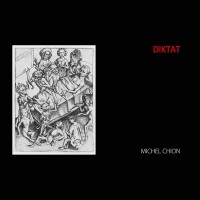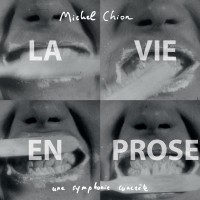Michel Chion (EA Bucket 18.)
|
Grant Chu Covell [April 2013.] Let me get it out of the way: Michel Chion (b. 1947) is one of the all-time best ea composers. His works operate on levels, well beyond those ea practitioners who peddle pretty sounds or tell stories. Some may find Chion’s compositions excessively manipulated because they are so precisely, perhaps relentlessly, delineated. When not crafting ea melodramas, Chion has thought deeply about sound and images (L’audio-vision, Son et image au cinema, etc.), and produced monographs on cinematic masters (David Lynch, Stanley Kubrick, et al.). The few Chion items have wandered in and out of print. In 2010 Nuun brought out 500 copies of Diktat (1979) and Brocoli’s La vie en prose was released last year. Michel CHION: Diktat (1979). Nuun 1. (2 CDs) (http://www.nuun-records.com/). Michel CHION: La vie en prose (2006-11). Brocoli 009 (2 CDs) (http://www.brocoli.org/). Diktat introduces an unreliable narrator, named Melchisedech in the notes, a “drunkard-prophet” who mumbles expressively in French and German, as well as in “Blavé,” an imaginary mother tongue. (Chion himself; Lanie Goodman will appear as “Donna Podorowski.”) Regardless of language, Melchisedech’s vocalizations are a sincere attempt to communicate. But do we hear what Melchisedech hears or are we listening to him remember? Perhaps this is all dreams and nightmares. The monodrama’s seven movements sketch an epic’s arc: Réveil, Amour, Le prophète, La vierge folle, Le travail, Agitation, Nuit (Awakening, Love, The Prophet, The Mad Virgin, Labors, Agitation, Night). At 82 minutes (36:42 + 45:15), the story proceeds unhurriedly, perhaps intentionally confusing and noncyclical. Recurring elements undergo transformations without development or resolution. What are we to make of a distant barking dog or a repeating minimalist synthesizer snippet? A percussive gesture becomes filtered and changes tempo. Nothing seems capricious, yet the narrative is indistinct. Familiar sounds fail to reassure. We recognize objects seen at different angles, and they’re still obscure. At first listen, Melchisedech’s passionate, vituperative nonsense implies that if we fail to understand the fault is ours. He is accompanied by a typewriter. We soon realize that his syllables don’t correspond to the machine’s clatter. The typewriter (with bell) takes on a life of its own, becoming gunfire when amplified. There are very few instrumental appearances and spare natural sounds (rain, animals) just barely suggesting place. It impresses that Chion took pains to create nonsense of great import. Subsequent exposures reveal that the audience isn’t meant to understand anything except its characters’ unhappy emotions from within a cramped and disturbed place, perhaps one touched by a devil. A listener may try to decipher what’s heard and then lose the narrative’s thin thread. Beyond the movement titles, Chion’s program note tweaks us with irrelevant details, e.g., Donna hails from Indianapolis. Diktat’s last movement, the 22:14 Nuit, appears as Nuit Noire (1979-85) on IMED-9312-CD with two other ea works, the extraordinary Requiem (1973) and Variations (1990). It’s not obvious how the versions differ. Emprientes Digitales indicates there were alterations to ensure that Nuit could stand alone. Chion’s note for Nuit Noire offers a dedication to Philip K. Dick and identifies the movement as a nightmare chronicling passage through states leading perhaps to death. Chion’s La vie en prose is a sprawling four-part (50:28 + 34:24) symphonia domestica. Other works, such as Diktat, suggest battles between good and evil, with saints and angels fighting the deranged and devils. La vie is a terrestrial humanist celebration of the concrete world. Chion’s note alleges no narrative, despite exact repetition. The third section of Le chant des heures (the Moderato first movement) repeats the opening seconds as in a sonata-allegro. Dans la chambre (the Adagio third movement) opens with a female narrator describing a family tableaux as if setting up an exercise on a foreign language tape. La vie displays the range to Chion’s virtuosity. A listener can tackle Chion’s work in many ways. First, try to recognize what’s offered. Le chant des heures has seven sections, the first 20 seconds of which feature clinking glass, a crowd at a sporting event, a man with a bad cough, a gun firing, breaking glass, someone sighing, water flushing and bells. Welcome to the land of concrète. There might be slight modifications (filtering, changing speed, immediate looping); we must puzzle out what we’ve heard. That the sounds are unrelated makes the job harder. It’s possible to enjoy Chion simply as a guessing game. Next we might try to make sense of associations. Clinking glassware could be someone washing dishes or something mechanical. Is the crowd acknowledging a goal? Who coughed? Where is he? He sounds sick. That firing gun is loud. Perhaps we’re outside? Sometimes we hear sounds which raise memories: Those rattling bottles conjure my favorite restaurant. Remember that last-minute goal that won the game? That cough reminds me to check in on someone. The mind races to make sense of it all and looks for relationships and logical connections. But perhaps the story isn’t evident. How can we hear a dishwasher at a sporting event? Why would someone fire a gun in a hospital? Broken glass can be dangerous. Is the singer safe? It takes effort to determine whether Chion intends anything. Maybe it’s an elaborate joke. The mind races. The exasperatingly nonlinear La vie plays with our inherent need to associate and apply order. La vie’s movie-length scale also prevents immediate comprehension. Sometimes two dissimilar sounds will occur simultaneously, juxtapositions impossible in the real world (resonant footsteps and crickets, a marching band on safari). Does this collage possess meaning? Or should we be content simply to listen to Chion’s interesting, if impossible, universe? We may also wrestle with points of view and references. Are we hearing what Chion’s embedded narrator hears (as in Diktat’s troubled Melchisedech), or is Chion addressing us? Other ea composers are content to create a few pretty sounds and then manipulate them ad nauseum. The listener doesn’t have to figure anything out and no improbable associations challenge the brain. If there’s a story, most composers take pains to arrange events sequentially to approximate reality. Not so Chion. La vie has no plot, except to capture daily life (the cover’s teeth brushing appears around 14:30 in Le souffle court). The recurring sounds become new acquaintances: animal noises, a crying baby, arcade music, prepared piano (suggesting Schaeffer’s earliest études), etc. Unlike other Chion, instrumental excerpts intrude and sometimes take precedence. While spoken bits are in French, other cultures appear: an African and Chinese ensemble become superimposed. I hear what might be a bit of early Ellington. There are persistent effects that sound like filtered drumbeats. Chion constructs persistent, intriguing relationships. The Scherzo is dedicated to Jerome Noetinger, who runs Metamkine, and the slow movement to fellow ea composer Christine Groult. At 28:33, the Scherzo is a huge whirlwind of thwarted expectations and bruised logic. Just after the ten-minute mark, for about a full minute, precise editing creates a series of improbable harmonic resolutions that hop among different genres. It’s quite brilliant.
[More EA Bucket, Grant Chu Covell]
[More
Chion]
[Previous Article:
Scardanelli’s April Motley]
[Next Article:
IPC’s Acoustic Energizer and Disc Energizer]
|

